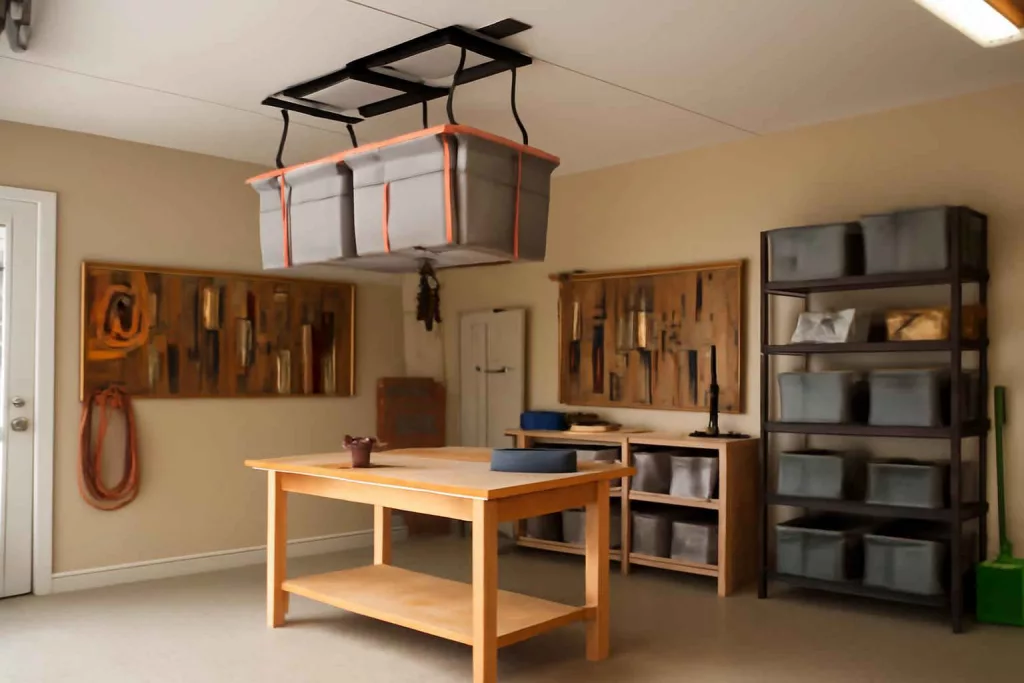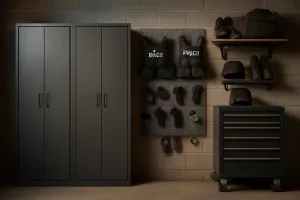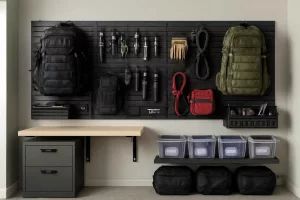Maximizing overhead space in a busy garage workshop is a game-changer for any DIY enthusiast or professional craftsman. Ceiling-mounted storage hoists lift bulky bins, bikes, and seasonal gear out of the way, freeing floor real estate for a sturdy heavy-duty workbench and tool chest. Whether you choose a manual pulley system or a motorized lift, a reliable garage ceiling storage hoist can be installed in a single afternoon. In this guide, we’ll explore why overhead hoists are worth the investment, how to pick the right model, and our top five ceiling-mounted storage hoists to help you reclaim your floor and wall space.
Why Choose Ceiling-Mounted Storage Hoists?
Garage and workshop floors quickly become cluttered with bins, seasonal décor, ladders, and tools. Installing a ceiling-mounted storage hoist not only clears walkways but also protects items from moisture and pests on the floor. By lifting storage bins up to the rafters, you create an organized workspace optimized for efficiency. Overhead hoists are especially valuable if you’ve already outfitted your walls with wall-mounted pegboard systems for garage organization or wall-mounted tool cabinets—they complete a three-dimensional storage plan.
Key benefits of ceiling hoists include raised storage for bulky or infrequently accessed items, reduced risk of trips and falls by keeping floor clear, and the ability to tailor shelf height to your needs. A sturdy hoist handling up to 150 pounds can hold multiple bins or even a small kayak, while requiring minimal ceiling space. With ceiling hoists, even a small garage can accommodate a full suite of organizational upgrades.
Types of Ceiling-Mounted Storage Hoists
Ceiling storage hoists fall into two primary categories: manual pulley systems and motorized (electric) hoists. Each type has its pros and cons, depending on your lifting frequency, budget, and physical considerations.
Manual Pulley Systems
Manual pulley hoists use a block-and-tackle arrangement to reduce lifting effort. By threading rope through multiple pulleys, you leverage mechanical advantage, making a 100-pound load feel like 20 pounds of lift. Manual hoists are typically more affordable, simple to install, and require no electrical wiring. Ideal for light-to-moderate use, they fit smaller garages or workshops without a spare outlet.
Electric (Motorized) Hoists
Electric hoists offer push-button convenience, lifting heavy loads with minimal effort. They run on standard garage power (120V) and often include remote controls or wall-mounted switches. While pricier and requiring professional installation for safety compliance, motorized hoists excel in high-frequency lifting scenarios, such as commercial garages or large home workshops. They also incorporate auto-brake systems to lock in place when power is off.
Key Features to Consider
Choosing the best ceiling-mounted storage hoist hinges on weighing capacity, build quality, installation requirements, and safety features. Let’s break down each factor.
Weight Capacity
Match hoist capacity to your heaviest expected load. If storing three 40-pound bins, select at least a 150-pound hoist to factor in weight variance and buffer. Manual hoists often range from 75 to 150 pounds, while electric units handle 250 pounds or more.
Construction and Materials
Look for hoists made of industrial-grade steel or aluminum with corrosion-resistant coatings. Nylon-coated cords or aircraft-grade rope increase durability. A sturdy mounting bracket and reinforced ceiling plate distribute weight evenly across ceiling joists.
Ease of Installation
Most manual systems bolt directly to two ceiling joists, while electric hoists may require a reinforced mount plate and nearby power source. Check ceiling height clearance and cord length—some hoists include extension kits for high rafters.
Safety and Lifting Mechanisms
Reliable braking systems, overload protection, and cord locks prevent accidental drops. Electric hoists should include automatic cut-off if the load exceeds capacity. Clear user manuals and labeled weight limits are essential.
Top Ceiling-Mounted Storage Hoists for Garage Workshops
1. Yale 75-Lb Capacity Manual Pulley Block and Tackle
The Yale manual pulley block offers a classic rope-and-pulley design, delivering a 4:1 mechanical advantage. Rated for 75 pounds, it’s ideal for lighter storage bins and seasonal sports equipment. The galvanized steel pulleys and braided rope resist rust and abrasion. Installation is straightforward: mount two joist brackets and adjust the rope length. For an affordable, no-frills solution, this Yale hoist remains a best-seller among hobbyists who need reliable overhead storage without wiring.
2. Racor 100-Lb Heavy-Duty Manual Hoist
Racor’s 100-pound manual hoist features a four-pulley, 16-foot rope length, making it easier to lift heavier loads with minimal effort. The reinforced steel pulleys and integrated rope handle reduce wear, while the safety latch prevents accidental slippage. Suitable for storing paint cans, small ladders, and sports gear, the Racor hoist pairs well with a heavy-duty workbench area to free up floor space for projects. Its corrosion-resistant finish ensures long-term performance even in damp garage environments.
3. GENIANI Electric Garage Hoist Lift (250-Lb Capacity)
The GENIANI electric hoist lifts up to 250 pounds at the push of a button and includes a wireless remote control. Its steel gear drive and automatic braking system lock the unit in place once the switch is released. A protective cover guards against dust and moisture, while the adjustable height control offers fine-tuned positioning. Though pricier, its powerful motor and safety overload sensor make it ideal for regularly moving heavy bins or tools—perfect for busy home mechanics and small business owners.
4. Yaheetech 110-Lb Rope Pulley Block with Mounting Bracket
This Yaheetech pulley block kit includes a mounting bracket, pulley wheels, and a 14-foot braided nylon rope. Rated for 110 pounds, it handles most storage bins and light equipment. The rope’s smooth action over sealed ball bearings makes lifting effortless, while the steel hook and safety clip secure loads firmly. Install on 16" O.C. joists and adjust rope length using the included cord organizers. It’s a budget-friendly choice that delivers solid performance for typical garage storage needs.
5. Rebel Manual 150-Lb Industrial Pulley Lift
Rebel’s manual lift boasts a hefty 150-pound capacity, allowing large plastic totes or even small ladders to be stored overhead. Dual heavy-duty pulleys with reinforced bearings reduce pulling effort to under 30 pounds. The integrated ratchet brake ensures the load stays locked at any height, eliminating rope slippage. Robust steel mounting hardware and a three-year warranty underscore its durability—perfect for seasoned DIYers who demand a reliable industrial-grade solution.
Installation Tips for Ceiling-Mounted Storage Hoists
Proper installation ensures safety and longevity. First, locate two adjacent ceiling joists using a stud finder and mark their centers. Pre-drill pilot holes for lag bolts, then secure the hoist’s mounting brackets. Use a level to confirm alignment. If installing an electric hoist, verify the nearest outlet can handle the motor’s amperage, and use a properly grounded GFCI circuit. Tie off excess rope and secure it with cord clips so it doesn’t dangle over walkways. Finally, test hoist operation under a moderate load before regular use.
Maintenance and Safety Guidelines
Regular inspection prevents accidents. Check rope or cord for fraying, pulleys for smooth rotation, and bolts for tightness every three months. Lubricate pulley bearings with a light machine oil. For electric hoists, inspect wiring and remote controls for damage, and ensure safety sensors function properly. Never exceed the rated capacity, and always keep hands and clothing clear of moving parts. Use sturdy containers that won’t deform under weight, and place heavier items closest to the ceiling to reduce stress on the hoist.
Frequently Asked Questions
Can I Install a Hoist on a Finished Ceiling?
Yes, but you must locate and mount into structural ceiling joists above the finish material. Avoid relying on drywall or plywood alone. Use long lag bolts that penetrate at least 2 inches into solid framing.
What Is the Difference Between 2:1 and 4:1 Pulley Systems?
A 2:1 system offers one-half the lifting effort, while a 4:1 system quarterizes the load. Higher mechanical advantage reduces pull force but requires more rope length.
How Do I Know if My Garage Ceiling Can Support a Hoist?
Inspect joist size and spacing — a standard 2×10 or 2×12 joist on 16" centers usually supports overhead storage. For heavier loads, reinforce with additional blocking or a support beam.
Conclusion
Ceiling-mounted storage hoists transform cluttered garages into streamlined workshops by lifting bulky items out of the way. From budget-friendly manual pulley systems to high-capacity electric lifts, there’s a hoist to fit every need and budget. Evaluate weight capacity, build quality, and installation ease, then choose one of our top picks to reclaim your floor space today. Ready to install? Grab your hoist, follow the step-by-step instructions above, and enjoy a safer, more organized garage workshop.






